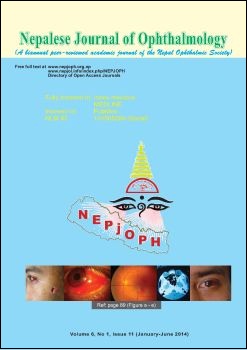Clinico-epidemiological characteristics of central retinal vein occlusion in a tertiary level eye care center of Nepal
DOI:
https://doi.org/10.3126/nepjoph.v6i1.10771Keywords:
central retinal vein occlusion, visual acuityAbstract
Background: Central retinal vein occlusion (CRVO) is one of the common retinal disorders causing severe visual impairment.
Objective: To study the clinical profile, risk factors and visual outcome in central retinal vein occlusion.
Materials and methods: Seventy-four eyes of 74 patients with central retinal vein occlusion were retrospectively enrolled during the period of one year. All the patients in the study were classified with regard to their ischemic status into two groups, ischemic CRVO and non-ischemic CRVO. The demographic pattern of the patients was recorded. The other parameters studied were visual acuity, history of glaucoma, hypertension, diabetes mellitus and hyperlipidemia. The patients were followed up at 1 month, 3 months and 6 months after treatment.
Results: The majority of the patients (n = 49, 66.2 %) had the ischemic type of CRVO, whereas, 25 (33.8 %) of them had the non-ischemic type. The CRVO was more commonly observed in males in both the groups. Hypertension was the most common risk factor associated with CRVO. The visual improvement was significantly better in non-ischemic CRVO (RR = 0.04, 95% CI = 0.01 – 0.31, p = 0.000).
Conclusion: The CRVO was more common in males than in females. It was associated with systemic hypertension. The ischemic type of the CRVO was more prevalent than the non-ischemic one in this study. Visual outcome was better in the non-ischemic CRVO.
DOI: http://dx.doi.org/10.3126/nepjoph.v6i1.10771
Nepal J Ophthalmol 2014; 6 (2): 39-45
Downloads
Downloads
Published
How to Cite
Issue
Section
License
This license enables reusers to copy and distribute the material in any medium or format in unadapted form only, for noncommercial purposes only, and only so long as attribution is given to the creator.




